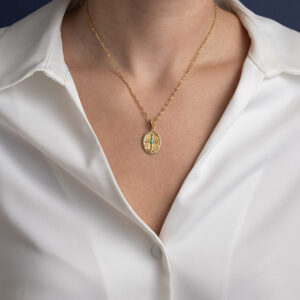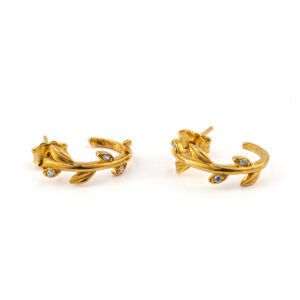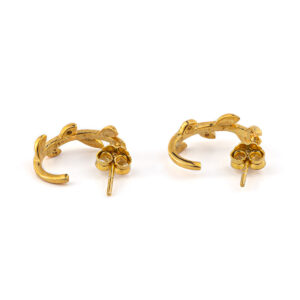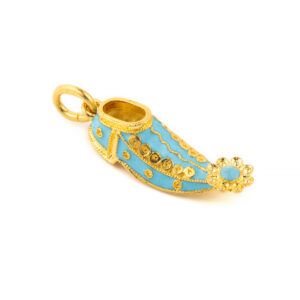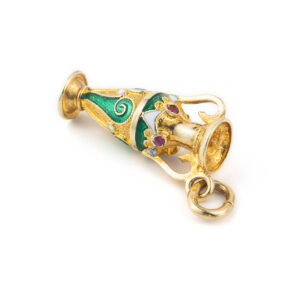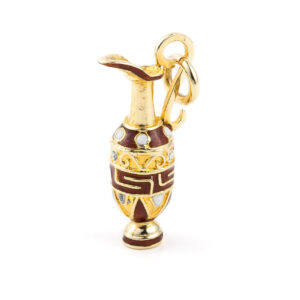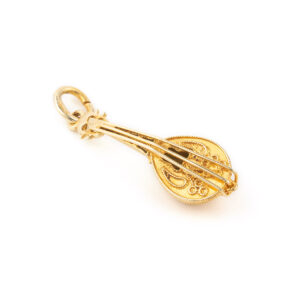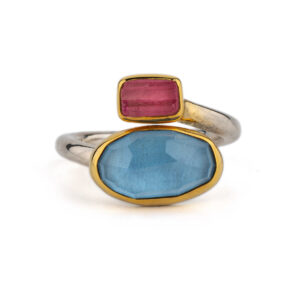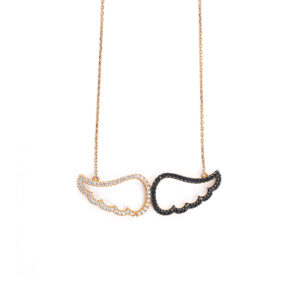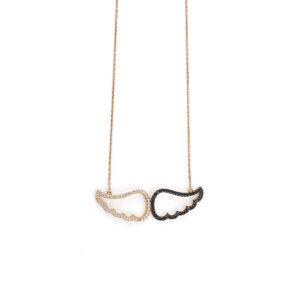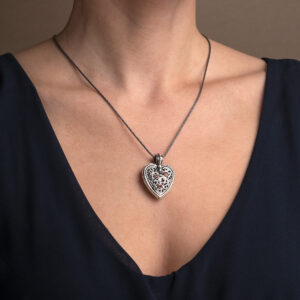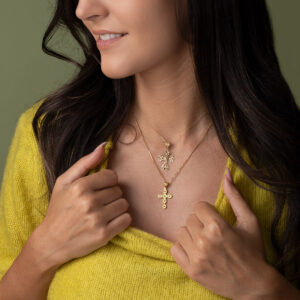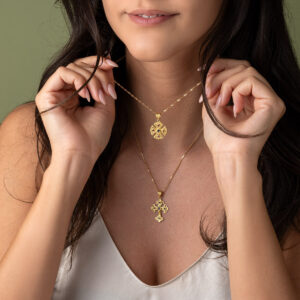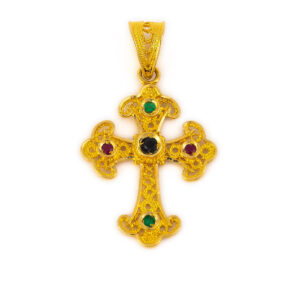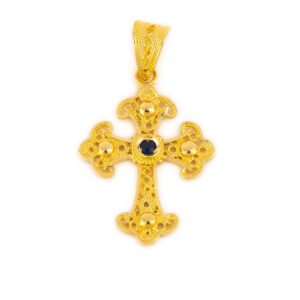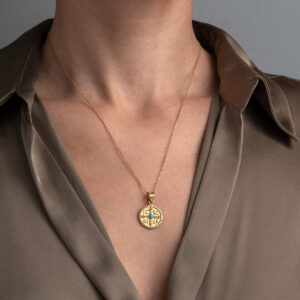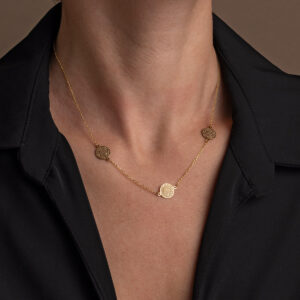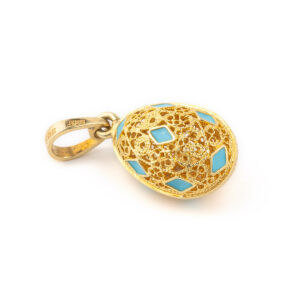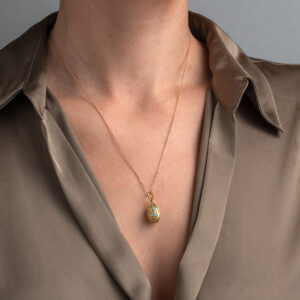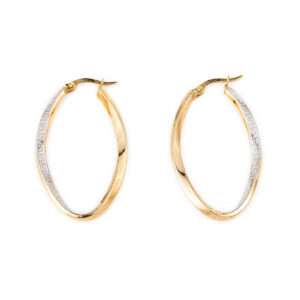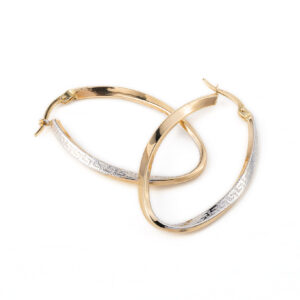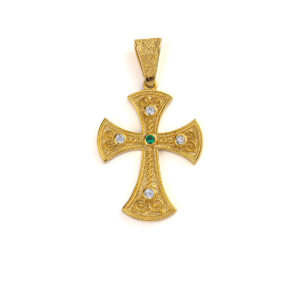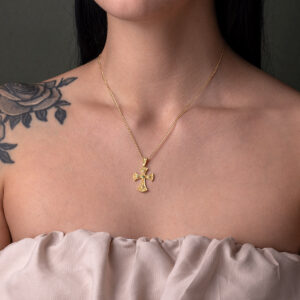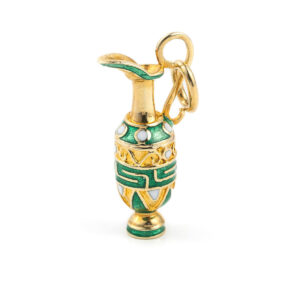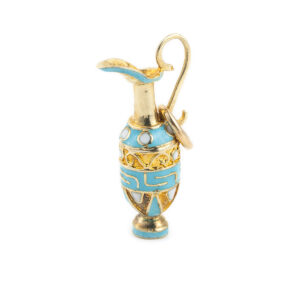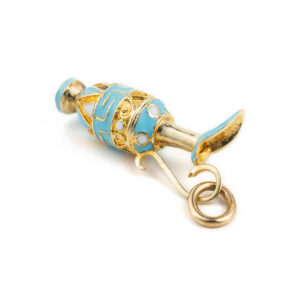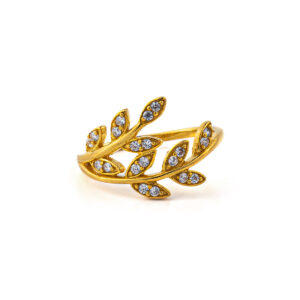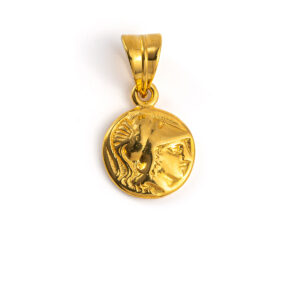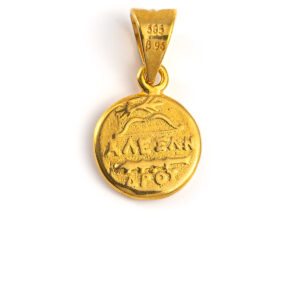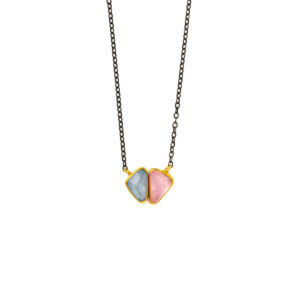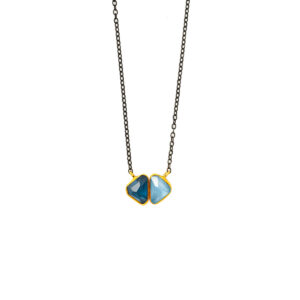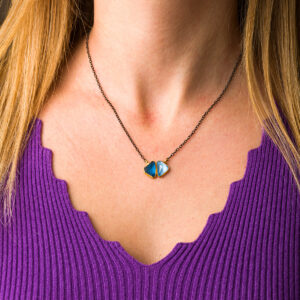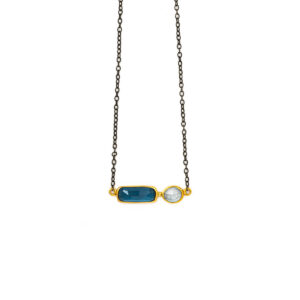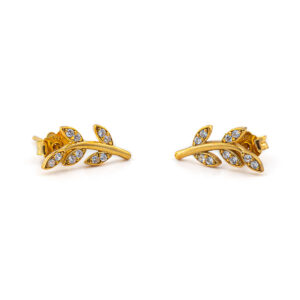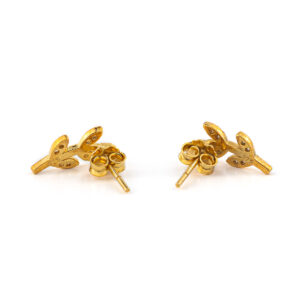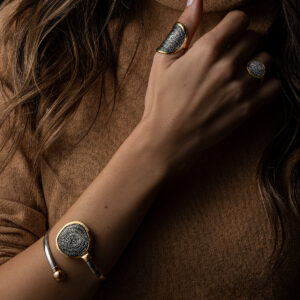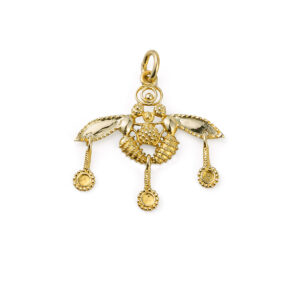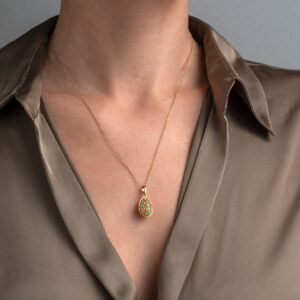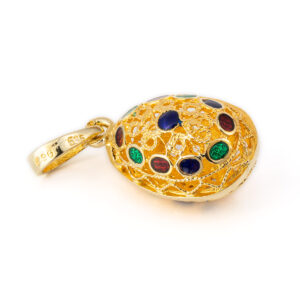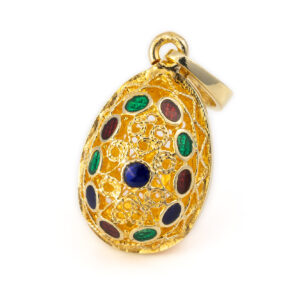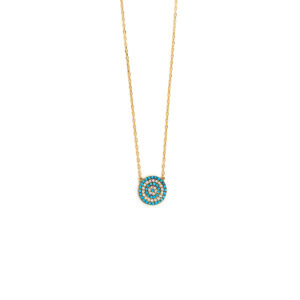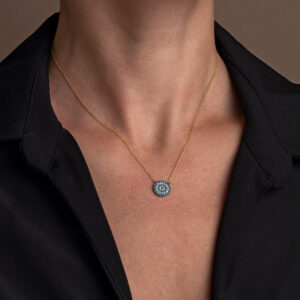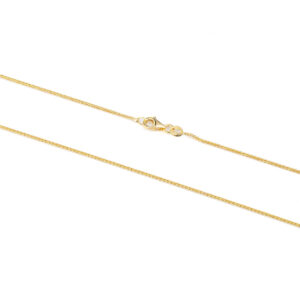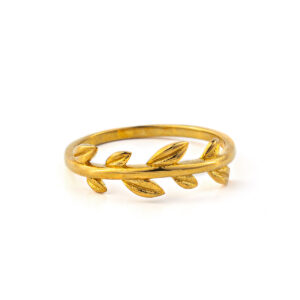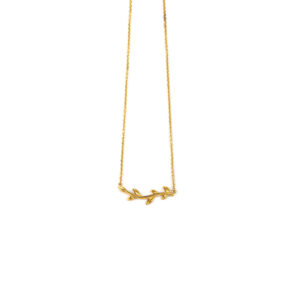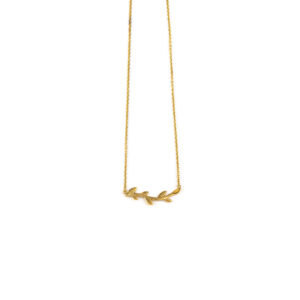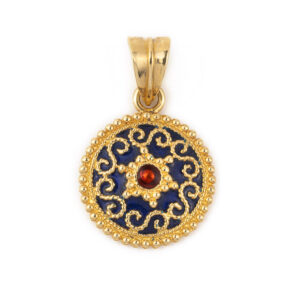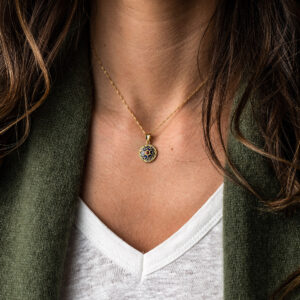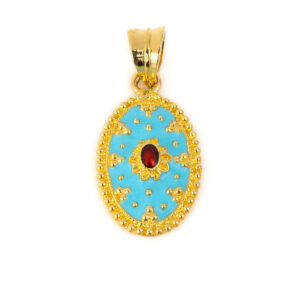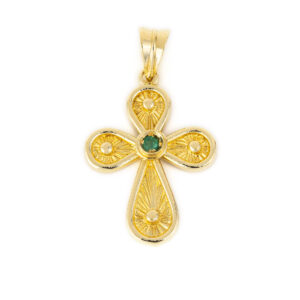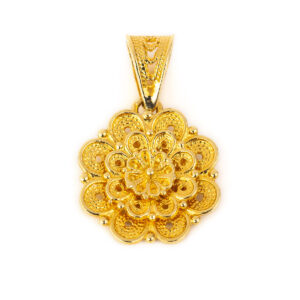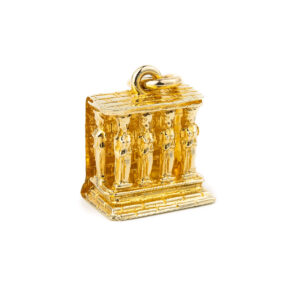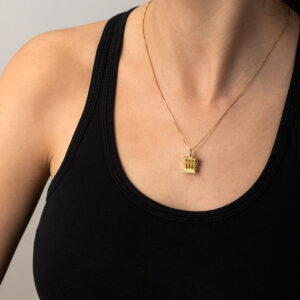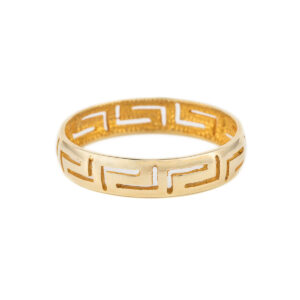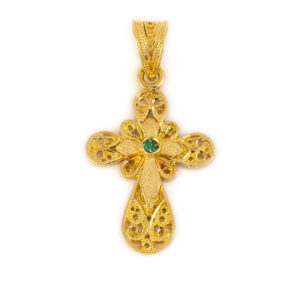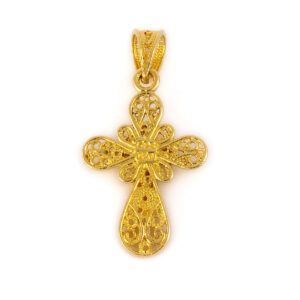Μενταγιόν Κωνσταντινάτο Οβάλ με Τυρκουάζ – 14Κ Χρυσό
624,00€Κατασκευασμένο από Χρυσό 14Κ.
Χειροποίητο Ελληνικό Κόσμημα.
Σκουλαρίκια Κλαδί – 14Κ Χρυσό με Ζιργκόν
620,00€Earrings inspired by the olive leaf symbol.
Made of 14k gold with zircon.
The olive wreath also known as kotinos was the prize for the winner at the ancient Olympic Games. It was an olive branch, of the wild- olive tree that grew at Olympia,intertwined to form a circle or a horse-shoe. According to Pausanias it was introduced by Heracles as a prize for the running race winner to honour his father Zeus. In the ancient Olympic Games there were no gold, silver, or bronze medals. There was only one winner per event, crowned with an olive wreath made of wild-olive leaves from a sacred tree near the temple of Zeus at Olympia. Olive wreaths were given out during the 2004 Summer Olympics in Athens in honor of the ancient tradition, because the games were being held in Greece.
Μενταγιόν Τσαρούχι – 14Κ Χρυσό
620,00€Have you witnessed the changing of the guards in Syntagma square? This is the most traditional shoe of Greece (tsarouhi). The pendant is decorated with turquoise enamel and rosette motif. The rosette (rose) is a timeless jewel, symbol and amulet. The origin of the term is the Greek word for rose – rodon (ρόδον). Its use began in the Mycenaean era and continues as far as the 2nd millennia BC. The Mycenaean Rosette is a motif that was widespread throughout Mesopotamia, Egypt, Greece and other ancient civilizations. Rosette or Rodax was probably the most popular and favorite decorative element in Mycenaean era, classical antiquity and Byzantine times.
Made in 14k yellow gold.
Used as a charm or as a pendant.
Design inspired by the Greek tradition
A tsarouchi (τσαρούχι) is a type of shoe, which is typically known nowadays as part of the traditional uniform worn by the Evzones of the Greek Presidential Guard. Their origin goes back to the Byzantine times. Originally, various types of similar shoes were worn all over the Balkans, but tsarouchia are mainly associated with the Greeks. They were the most common footwear worn by both urban and rural Greeks, mainly men, but also many women. After the Greek independence in early 19th century, their use was limited to isolated rural areas and nomadic populations. Tsarouciia provide a clear link with the origin of the Evzone uniform in the traditional Greek costume, and with the fact that Evzones were largely enlisted from rural mountainous regions of Greece. Nowadays they are almost exclusively used by the presidential guard and in various traditional festivals and dances along with other traditional Greek garments.(source wikipedia)
Μενταγιόν Αμφορέας – 14Κ Χρυσό
620,00€Ancient Greek Amphora Pendant with green enamel.
Design inspired by the ancient Greek history.
Made in 14k yellow gold
Also available with red or turquoise enamel
Handmade item
Amphora is a Greco – Roman word developed in ancient Greek during the Bronze Age. An amphora is a type of container of a characteristic shape and size. Amphorae were used for the transport and storage of various products, both liquid and dry, but mostly for wine. They are most often ceramic. the amphorae used in Ancient Greek vase painting. (source wikipedia)
Μενταγιόν Αμφορέας – 14Κ Χρυσό
620,00€Ancient Greek Amphora Pendant with red enamel and Meander design.
Design inspired by the ancient Greek history.
Made in 14k yellow gold
Also available with turquoise or blue enamel
Available in 3 sizes.
Handmade item.
The chain shown is our 14K Gold Chain (not included).
Amphora is a Greco – Roman word developed in ancient Greek during the Bronze Age. An amphora is a type of container of a characteristic shape and size. Amphorae were used for the transport and storage of various products, both liquid and dry, but mostly for wine. They are most often ceramic. the amphorae used in Ancient Greek vase painting. (source wikipedia)
Meander or Meandros design, one of the most historic symbols of the Greek World, also called Greek Key and symbolizes long life and eternity. The pattern with Meander was used in antiquity to decorate the frieze of temples.
14kt Yellow Gold Greek Bouzouki Charm Pendant
620,00€Made in 14k yellow gold.
Handmade in Greece.
Used as a charm or as a pendant.
Design inspired by the Greek tradition
Explore Heritage Collection
History
The Greek bouzouki is a plucked musical instrument of the lute family, called the thabouras or tambouras family. The tambouras existed in ancient Greece as the pandura, and can be found in various sizes and shapes. The bouzouki and the baglamas are the direct descendants. The bouzouki arrived in Greece following the 1919–1922 war in Asia Minor and the subsequent population exchange between Greece and Turkey. The early bouzoukia mostly had three courses. At the end of the 1950s, four-course (tetrachordo) bouzoukia started to gain popularity. The four-course bouzouki was made popular by Manolis Chiotis. Manolis Chiotis was a Greek rebetiko and laiko composer, singer, and bouzouki player. He is considered one of the greatest bouzouki soloists of all time.
Δαχτυλίδι Τουρμαλίνη και Aqua Marine – Χρυσό 18Κ και Ασήμι 925
620,00€Κατασκευασμένο από 18Κ χρυσό και ασήμι 925.
Διακοσμημένο με Aqua Marine και Τουρμαλίνη.
Χειροποίητο ελληνικό κόσμημα.
Όπως σε όλα τα χειροποίητα είδη μπορεί να υπάρχουν μικρές διαφορές σε βάρος και διαστάσεις και αυτό είναι που τα κάνει μοναδικά και πολύτιμα.
Χρυσό κολιέ φτερά 14K με Ζιργκόν
620,00€Χρυσό κολιέ φτερά 14K με Ζιργκόν
Κολιέ κόσμημα φτερά κατασκευασμένο από ροζ χρυσό 14Κ, διακοσμημένο με λευκές και μαύρες πέτρες ζιργκόν.
Gerochristo – Μενταγιόν Garden Shadows Καρδιά από Χρυσό 18Κ και Ασήμι 925 με Ρουμπίνια
616,00€Μενταγιόν καρδιά, διακοσμημένο με φιλιγκράν, χειροποίητο με ιδιαίτερη προσοχή στη λεπτομέρεια.
Αγκαλιάστε την κομψότητα με το μεσαίο κρεμαστό κόσμημα καρδιάς Garden Shadows από χρυσό 18 καρατίων και ασήμι 925 με ρουμπίνια. Αυτό το εξαίσιο κρεμαστό κόσμημα, που διαθέτει ένα εντυπωσιακό μοτίβο καρδιάς, συμβολίζει την αγάπη και είναι ιδανικό για όσους εκτιμούν τα πιο εκλεπτυσμένα πράγματα στη ζωή.
Το μενταγιόν διαθέτει κομψές λεπτομέρειες, που ενισχύουν τη συνολική γοητεία του.
Ιδανικό για ειδικές περιστάσεις, ως δώρο αγάπης.
Χειροποίητο ελληνικό κόσμημα.
Ανακαλύψτε τη Συλλογή Valentine by Gerochristo
14k Gold Byzantine Cross With Multi Stones
615,00€Beautiful Cross Pendant made of 14K Solid Gold.
Handmade in Greece
Explore Religious Collection
18k Gold Filigree Byzantine Cross With Sapphire
609,00€Discover the beauty of timeless craftsmanship with this stunning 18k gold Byzantine filigree cross pendant. This handmade piece draws inspiration from the intricate patterns of traditional Byzantine jewelry. The front showcases delicate filigree detailing, while the reverse is polished and unadorned for a classic finish.
Perfect as a religious gift or statement pendant, this handcrafted gold cross celebrates both faith and art. Ideal for those searching for Byzantine gold jewelry, handmade gold crosses, or 18k religious pendants.
Explore Religious Collection
18Κ Χρυσός Σταυρός με Ημιπολύτιμους Λίθους
609,00€Σταυρός εμπνευσμένος από τη βυζαντινή εποχή.
Κατασκευασμένος από χρυσό 18 Καρατίων.
18Κ Χρυσός Σταυρός με Ζαφείρι
609,00€Σταυρός εμπνευσμένος από τη βυζαντινή εποχή.
Κατασκευασμένος από χρυσό 18 Καρατίων.
Μενταγιόν Κωνσταντινάτο με Τυρκουάζ – 14Κ Χρυσό
605,00€Κατασκευασμένο από Χρυσό 14Κ.
Χειροποίητο Ελληνικό Κόσμημα.
Κολιέ Δίσκος της Φαιστού – Χρυσό 14Κ
605,00€Κατασκευασμένο από 14Κ χρυσό.
Ο Δίσκος της Φαιστού είναι ένας δίσκος από πηλό από το μινωικό παλάτι της Φαιστού στο νησί της Κρήτης. Τώρα, το νησί της Κρήτης είναι μέρος της σύγχρονης Ελλάδας. Ο δίσκος ανακαλύφθηκε το 1908 από τον Ιταλό αρχαιολόγο Luigi Pernier στο μινωικό παλάτι της Φαιστού. Ακόμα και στις μέρες μας η αποκρυπτογράφηση του δεν είναι ξεκάθαρη, καθιστώντας το ένα από τα πιο διάσημα μυστήρια της αρχαιολογίας. Ο δίσκος έχει διάμετρο περίπου 15 εκατοστά και καλύπτεται και στις δύο πλευρές με μια σπείρα από σφραγισμένα σύμβολα. Ο δίσκος διαθέτει 241 μάρκες, που περιλαμβάνουν 45 ξεχωριστά σημάδια, τα οποία φτιάχτηκαν προφανώς πιέζοντας ιερογλυφικές «σφραγίδες» σε ένα δίσκο από μαλακό πηλό, με μια δεξιόστροφη ακολουθία που στρέφεται προς το κέντρο του δίσκου. Αυτό το μοναδικό αντικείμενο εκτίθεται τώρα στο αρχαιολογικό μουσείο Ηρακλείου. Κατασκευασμένο από χρυσό 14 καρατίων.
Χειροποίητο ελληνικό κόσμημα.
Δαχτυλίδι Κλαδί – 14Κ Χρυσό με Ζιργκόν
602,00€Ring inspired by the olive leaf symbol.
Made of 14k gold with zircon.
The olive wreath also known as kotinos was the prize for the winner at the ancient Olympic Games. It was an olive branch, of the wild- olive tree that grew at Olympia,intertwined to form a circle or a horse-shoe. According to Pausanias it was introduced by Heracles as a prize for the running race winner to honour his father Zeus. In the ancient Olympic Games there were no gold, silver, or bronze medals. There was only one winner per event, crowned with an olive wreath made of wild-olive leaves from a sacred tree near the temple of Zeus at Olympia. Olive wreaths were given out during the 2004 Summer Olympics in Athens in honor of the ancient tradition, because the games were being held in Greece.
Δίχρωμα Σκουλαρίκια Μαίανδρος – 14Κ Χρυσο
602,00€14k Gold Meander Oval Hoop Earrings
Meandros design is a decorative border constructed from a continuous line, shaped into a repeated motif. Such a design is also called the Greek fret or Greek key design, although these are modern designations. One the one hand, the name “meander” recalls the twisting and turning path of the Meander River in Asia Minor, and on the other hand, as Karl Kerenyi pointed out, “the meander is the figure of a labyrinth in linear form” the meaning is that these is no beginning and to end in some cases so it become the symbol of long life and eternity.
Handmade item.
Χρυσός Βυζαντινός Σταυρός 14 Καρατίων με Ζιργκόν
598,00€Όμορφος κρεμαστός σταυρός από χρυσό 14Κ.
Χειροποίητο Ελληνικό Κόσμημα
Ανακαλύψτε τη Συλλογή Πίστη
Μενταγιόν Αμφορέας – 14Κ Χρυσό
592,00€Ancient Greek Amphora Pendant with turquoise enamel.
Design inspired by the ancient Greek history.
Made in 14k yellow gold
Also available with red or green enamel
Handmade item
Amphora is a Greco – Roman word developed in ancient Greek during the Bronze Age. An amphora is a type of container of a characteristic shape and size. Amphorae were used for the transport and storage of various products, both liquid and dry, but mostly for wine. They are most often ceramic. the amphorae used in Ancient Greek vase painting.
Μενταγιόν Αμφορέας – 14Κ Χρυσό
592,00€Ancient Greek Amphora Pendant with green enamel and Meander design.
Design inspired by the ancient Greek history.
Made in 14k yellow gold
Also available with red or turquoise enamel
Available in 3 sizes
Handmade item
As in all handmade items there may be small differences in weight and dimensions and this is what makes them unique and precious.
Amphora is a Greco – Roman word developed in ancient Greek during the Bronze Age. An amphora is a type of container of a characteristic shape and size. Amphorae were used for the transport and storage of various products, both liquid and dry, but mostly for wine. They are most often ceramic. the amphorae used in Ancient Greek vase painting. (source wikipedia)
Meander or Meandros design, one of the most historic symbols of the Greek World, also called Greek Key and symbolizes long life and eternity. The pattern with Meander was used in antiquity to decorate the frieze of temples.
Μενταγιόν Αμφορέας – 14Κ Χρυσό
592,00€Ancient Greek Amphora Pendant with Turquoise enamel and Meander design.
Design inspired by the ancient Greek history.
Made in 14k yellow gold
Also available with red or blue enamel
Available in 3 sizes
Handmade item
Amphora is a Greco – Roman word developed in ancient Greek during the Bronze Age. An amphora is a type of container of a characteristic shape and size. Amphorae were used for the transport and storage of various products, both liquid and dry, but mostly for wine. They are most often ceramic. the amphorae used in Ancient Greek vase painting. (source wikipedia)
Meander or Meandros design, one of the most historic symbols of the Greek World, also called Greek Key and symbolizes long life and eternity. The pattern with Meander was used in antiquity to decorate the frieze of temples.
Δαχτυλίδι Κλαδί – 14Κ Χρυσό με Ζιργκόν
582,00€Ring inspired by the olive leaf symbol.
Made of 14k gold with zircon.
The olive wreath also known as kotinos was the prize for the winner at the ancient Olympic Games. It was an olive branch, of the wild- olive tree that grew at Olympia,intertwined to form a circle or a horse-shoe. According to Pausanias it was introduced by Heracles as a prize for the running race winner to honour his father Zeus. In the ancient Olympic Games there were no gold, silver, or bronze medals. There was only one winner per event, crowned with an olive wreath made of wild-olive leaves from a sacred tree near the temple of Zeus at Olympia. Olive wreaths were given out during the 2004 Summer Olympics in Athens in honor of the ancient tradition, because the games were being held in Greece.
Κολιέ με Ακουαμαρίνα και Ροζ χαλαζία – Χρυσό 18 Καρατίων και Ασήμι 925
580,00€Κολιέ με Ροζ χαλαζία και Ακουαμαρίνα σε ασήμι και χρυσό Κ18. Περιλαμβάνεται ασημένια αλυσίδα μήκους 40cm. Για μοναδικές εμφανίσεις γεμάτες χρώμα! Κάθε κόσμημα της σειράς είναι μοναδικό.
Δαχτυλίδι Κλαδί – 14Κ Χρυσό με Ζιργκόν
578,00€Ring inspired by the olive leaf symbol.
Made of 14k gold with zircon.
The olive wreath also known as kotinos was the prize for the winner at the ancient Olympic Games. It was an olive branch, of the wild- olive tree that grew at Olympia,intertwined to form a circle or a horse-shoe. According to Pausanias it was introduced by Heracles as a prize for the running race winner to honour his father Zeus. In the ancient Olympic Games there were no gold, silver, or bronze medals. There was only one winner per event, crowned with an olive wreath made of wild-olive leaves from a sacred tree near the temple of Zeus at Olympia. Olive wreaths were given out during the 2004 Summer Olympics in Athens in honor of the ancient tradition, because the games were being held in Greece.
Goddess Athena Coin Pendant – 14K Gold
577,00€Α beautiful and timeless Coin Pendant with Goddess Athena.
The back side is decorated with the inscription: Alexandrou in Greek fonts.
Made in 14k gold.
Dracma was the currency used in Greece during several periods in its history.
The tetradrachm was an Ancient Greek silver coin equivalent to fourdrachmae in Athens it replaced the earlier “heraldic” type of didrachms and it was in wide circulation from ca. 510 to ca. 38 BC.
This coin illustrate the portrait of Goddess. The inscription of Alexander is engraved on the reverse. Athena is an ancient Greek goddess associated with wisdom, handicraft, and warfare.
Athena was regarded as the patron and protectress of various cities across Greece, particularly the city of Athens, from which she most likely received her name. She’s usually shown in art wearing a helmet and holding a spear. Her major symbols include owls, olive trees, and snakes. Her temples were located atop the fortified Acropolis in the central part of the city. The Parthenon on the Athenian Acropolis is dedicated to her, along with numerous other temples and monuments. Her main festival in Athens was the Panathenaia, which was celebrated in midsummer and was the most important festival on the Athenian calendar.
In the classical Olympian pantheon, Athena was regarded as the favorite daughter of Zeus.
As in all handmade items there may be small differences in weight and dimensions and this is what makes them unique and precious.
Κολιέ με Ροζ χαλαζία και Ακουαμαρίνα – Χρυσό 18 Καρατίων και Ασήμι 925
575,00€Κολιέ με Ροζ χαλαζία και Ακουαμαρίνα σε ασήμι και χρυσό Κ18. Περιλαμβάνεται ασημένια αλυσίδα μήκους 40cm. Για μοναδικές εμφανίσεις γεμάτες χρώμα! Κάθε κόσμημα της σειράς είναι μοναδικό.
Κολιέ με Ακουαμαρίνα και Τοπάζ – Χρυσό 18 Καρατίων και Ασήμι 925
575,00€Κολιέ με τοπάζ και ακουαμαρίνα σε ασήμι και χρυσό Κ18. Περιλαμβάνεται ασημένια αλυσίδα μήκους 40cm. Για μοναδικές εμφανίσεις γεμάτες χρώμα! Κάθε κόσμημα της σειράς είναι μοναδικό.
Κολιέ με Blue London Τοπάζ και Ακουαμαρίνα – Χρυσό 18 Καρατίων και Ασήμι 925
574,00€Κολιέ με Blue London Τοπάζ και Ακουαμαρίνα σε ασήμι και χρυσό Κ18. Περιλαμβάνεται ασημένια αλυσίδα μήκους 40cm. Για μοναδικές εμφανίσεις γεμάτες χρώμα! Κάθε κόσμημα της σειράς είναι μοναδικό.
Σκουλαρίκια Κλαδί – 14Κ Χρυσό με Ζιργκόν
568,00€Earrings inspired by the olive leaf symbol.
Made of 14k gold with zircon.
The olive wreath also known as kotinos was the prize for the winner at the ancient Olympic Games. It was an olive branch, of the wild- olive tree that grew at Olympia,intertwined to form a circle or a horse-shoe. According to Pausanias it was introduced by Heracles as a prize for the running race winner to honour his father Zeus. In the ancient Olympic Games there were no gold, silver, or bronze medals. There was only one winner per event, crowned with an olive wreath made of wild-olive leaves from a sacred tree near the temple of Zeus at Olympia. Olive wreaths were given out during the 2004 Summer Olympics in Athens in honor of the ancient tradition, because the games were being held in Greece.
Δαχτυλίδι Κλαδί – 14Κ Χρυσό
560,00€Ring inspired by the olive leaf symbol.
Made of 14k gold.
The olive wreath also known as kotinos was the prize for the winner at the ancient Olympic Games. It was an olive branch, of the wild- olive tree that grew at Olympia,intertwined to form a circle or a horse-shoe. According to Pausanias it was introduced by Heracles as a prize for the running race winner to honour his father Zeus. In the ancient Olympic Games there were no gold, silver, or bronze medals. There was only one winner per event, crowned with an olive wreath made of wild-olive leaves from a sacred tree near the temple of Zeus at Olympia. Olive wreaths were given out during the 2004 Summer Olympics in Athens in honor of the ancient tradition, because the games were being held in Greece.
Βραχιόλι Ανοιχτό Δίσκος της Φαιστού – Χρυσό 14Κ και Ασήμι 925
Κατασκεαυσμένο από Χρυσό 14Κ και Ασήμι 925.
Χειροποίητο ελληνικό κόσμημα.
Ο Δίσκος της Φαιστού είναι ένας δίσκος από πηλό από το μινωικό παλάτι της Φαιστού στο νησί της Κρήτης. Τώρα, το νησί της Κρήτης είναι μέρος της σύγχρονης Ελλάδας. Ο δίσκος ανακαλύφθηκε το 1908 από τον Ιταλό αρχαιολόγο Luigi Pernier στο μινωικό παλάτι της Φαιστού. Ακόμα και στις μέρες μας η αποκρυπτογράφηση του δεν είναι ξεκάθαρη, καθιστώντας το ένα από τα πιο διάσημα μυστήρια της αρχαιολογίας. Ο δίσκος έχει διάμετρο περίπου 15 εκατοστά και καλύπτεται και στις δύο πλευρές με μια σπείρα από σφραγισμένα σύμβολα. Ο δίσκος διαθέτει 241 μάρκες, που περιλαμβάνουν 45 ξεχωριστά σημάδια, τα οποία φτιάχτηκαν προφανώς πιέζοντας ιερογλυφικές «σφραγίδες» σε ένα δίσκο από μαλακό πηλό, με μια δεξιόστροφη ακολουθία που στρέφεται προς το κέντρο του δίσκου. Αυτό το μοναδικό αντικείμενο εκτίθεται τώρα στο αρχαιολογικό μουσείο Ηρακλείου
Μενταγιόν Μινωική Χρυσή Μέλισσα από 14Κ Χρυσό
320,00€ – 556,00€Εμπνευσμένο από τις αρχαιοελληνικές μινωικές μέλισσες στα Μάλια.
Κατασκευασμένο από χρυσό 14Κ.
Χειροποίητο ελληνικό κόσμημα.
Ανακαλύψτε τη Συλλογή Κληρονομιά
Το μενταγιόν των μινωικών μελισσών, ένα από τα πιο διάσημα μινωικά έργα τέχνης, ανακαλύφθηκε στο νεκροταφείο του Παλαιού Ανακτόρου στο Χρυσόλακκο, έξω από το ανάκτορο των Μαλίων, το τρίτο μεγαλύτερο και σημαντικότερο γνωστό μινωικό ανάκτορο μετά την Κνωσσό και τη Φαιστό. Χρυσόλακκος σημαίνει “Λάκκος του χρυσού” λόγω των πολλών πολύτιμων αντικειμένων που βρέθηκαν εκεί. Το διάσημο μενταγιόν χρονολογείται από την Εποχή του Χαλκού, (1800 π.Χ.) και είναι μια εκπληκτική, πολύ λεπτομερής αναπαράσταση δύο μελισσών ή σφηκών που αποθηκεύουν μια σταγόνα μέλι στην κηρήθρα τους. Αυτό το μενταγιόν είναι ένα από τα πιο διάσημα εκθέματα στο θαυμαστό αρχαιολογικό μουσείο του Ηρακλείου.
Σκουλαρίκια Σταγόνα με Μαίανδρο – 14Κ Χρυσό
556,00€14K Gold Meander Dangling Earrings
Meandros design is a decorative border constructed from a continuous line, shaped into a repeated motif. Such a design is also called the Greek fret or Greek key design, although these are modern designations. One the one hand, the name “meander” recalls the twisting and turning path of the Meander River in Asia Minor, and on the other hand, as Karl Kerenyi pointed out, “the meander is the figure of a labyrinth in linear form” the meaning is that these is no beginning and to end in some cases so it become the symbol of long life and eternity.
Handmade item.
Μενταγιόν Αυγό – Χρυσό 14Κ και Τυρκουάζ Σμάλτο
556,00€Κατασκευασμένο από Χρυσό 14Κ.
Χειροποίητο Ελληνικό κόσμημα.
Μενταγιόν Αυγό – Χρυσό 14Κ και Πολύχρωμο Σμάλτο
556,00€Κατασκευασμένο από Χρυσό 14Κ.
Χειροποίητο Ελληνικό κόσμημα.
Κολιέ Μάτι με Αλυσίδα από Κίτρινο Χρυσό 14Κ με ζιργκόν και τυρκουάζ
556,00€Μάτι διακοσμημένο με ζιργκόν και τυρκουάζ. Η αλυσίδα είναι από κίτρινο χρυσό 14 καρατίων. Ένα υπέροχο και κομψό κόσμημα για όλες τις ώρες.
Αλυσίδα Palma – 14Κ Χρυσό
535,00€ – 554,00€Κατασκευασμένη από 14Κ χρυσό.
Χειροποίητο Ελληνικό κόσμημα.
Δαχτυλίδι Κλαδί – 18Κ Χρυσό
554,00€Ring inspired by the olive leaf symbol.
Made of 18k gold.
The olive wreath also known as kotinos was the prize for the winner at the ancient Olympic Games. It was an olive branch, of the wild- olive tree that grew at Olympia,intertwined to form a circle or a horse-shoe. According to Pausanias it was introduced by Heracles as a prize for the running race winner to honour his father Zeus. In the ancient Olympic Games there were no gold, silver, or bronze medals. There was only one winner per event, crowned with an olive wreath made of wild-olive leaves from a sacred tree near the temple of Zeus at Olympia. Olive wreaths were given out during the 2004 Summer Olympics in Athens in honor of the ancient tradition, because the games were being held in Greece.
Κολιέ Κλαδί – 18Κ Χρυσό με Διαμάντια
554,00€Made of 18K gold.
A necklace inspired from the olive branch, a symbol of peace, abundance and achievement.
Handmade item.
Στρογγυλό Μενταγιόν από Χρυσό 18Κ με Μπλε και Κόκκινο Σμάλτο
554,00€Αρχαίο ελληνικό στρογγυλό μενταγιόν με μπλε και κόκκινο σμάλτο και κόκκους από πολύτιμο μέταλλο. Η πίσω πλευρά του μενταγιόν δεν έχει διακόσμηση.
Σχεδιασμός εμπνευσμένος από την απίστευτη ομορφιά της ελληνικής ιστορικής παράδοσης.
Κατασκευασμένο από χρυσό 18 καρατίων.
Η αλυσίδα που απεικονίζεται είναι η 14κ χρυσή αλυσίδα μας 40cm (δεν περιλαμβάνεται).
Διατίθεται επίσης με σμάλτο τυρκουάζ.
Χειροποίητο αντικείμενο.
Αυτή η τεχνική ονομάζεται κοκκοποίηση. Η κοκκοποίηση (από το λατινικό: granum = “κόκκος”) είναι μια τεχνική κοσμημάτων με την οποία η επιφάνεια ενός κοσμήματος καλύπτεται με μικρές σφαίρες ή κόκκους πολύτιμου μετάλλου. Η τεχνική θεωρείται ότι έχει τις ρίζες της στη Μεσοποταμία πριν από περίπου 5.000 χρόνια. Όπως σε όλα τα χειροποίητα αντικείμενα μπορεί να υπάρχουν μικρές διαφορές στο βάρος και τις διαστάσεις και αυτό είναι που τα κάνει μοναδικά και πολύτιμα.
Μενταγιόν από Χρυσό 18Κ με Τυρκουάζ Σμάλτο
554,00€Βυζαντινό μενταγιόν διακοσμημένο με λεπτό φιλιγκράν, τυρκουάζ σμάλτο και κόκκους από πολύτιμο μέταλλο. Χειροποίητο ελληνικό προιόν με μεγάλη προσοχή στη λεπτομέρεια.
Εμπνευσμένο από τη βυζαντινή τέχνη.
Κατασκευασμένο από χρυσό 18 καρατίων
Η κοκκοποίηση (από τα λατινικά: granum = «κόκκος») είναι μια τεχνική κοσμηματοποιίας με την οποία η επιφάνεια ενός κοσμήματος καλύπτεται με μικρές σφαίρες ή κόκκους πολύτιμου μετάλλου. Η τεχνική θεωρείται ότι έχει τις ρίζες της στη Μεσοποταμία πριν από περίπου 5.000 χρόνια.
14Κ Χρυσός Βυζαντινός Σταυρός με Σμαράγδι
540,00€Βυζαντινός σταυρός διακοσμημένος με σμαραγδί στη μέση και κόκκους από πολύτιμο μέταλλο.
Χειροποίητο ελληνικό κόσμημα με μεγάλη προσοχή στη λεπτομέρεια.
Εμπνευσμένο από τη βυζαντινή τέχνη.
Κατασκευασμένο από χρυσό 14 καρατίων.
Η αλυσίδα που απεικονίζεται είναι ηΧρυσή Αλυσίδα 14Κ σε μήκος 40cm (δεν περιλαμβάνεται).
Το φιλιγκράν είναι ένα λεπτεπίλεπτο είδος μεταλλικής κοσμηματοποιίας, κατασκευασμένο με μικροσκοπικές χάντρες ή στριφτά νήματα, ή και τα δύο σε συνδυασμό, συγκολλημένα μεταξύ τους ή στην επιφάνεια ενός αντικειμένου από το ίδιο μέταλλο και τοποθετημένα σε καλλιτεχνικά μοτίβα. Η τέχνη του φιλιγκράν χρονολογείται από την αρχαία ιστορία. Τα πρώτα από τα κοσμήματα που βρέθηκαν με αυτή την τεχνική έχουν βρεθεί στη Μεσοποταμία και χρονολογούνται χιλιάδες χρόνια π.Χ. Στον αρχαίο κόσμο και ιδιαίτερα στη Μικρά Ασία, η τέχνη αυτή αναπτύχθηκε ήταν στο υψηλότερο επίπεδο.
Η κοκκοποίηση (από τα λατινικά: granum = «κόκκος») είναι μια τεχνική κοσμημάτων κατά την οποία η επιφάνεια ενός κοσμήματος καλύπτεται με μικρές σφαίρες ή κόκκους πολύτιμου μετάλλου. Η τεχνική θεωρείται ότι έχει τις ρίζες της στη Μεσοποταμία πριν από περίπου 5.000 χρόνια.
18K Χρυσό Μενταγιόν Φιλιγκράν Βυζαντινής Ροζέτας
535,00€18K Χρυσό Μενταγιόν Φιλιγκράν Βυζαντινής Ροζέτας
Βυζαντινό κρεμαστό κόσμημα που έχει το σχήμα της ροζέτας λουλουδιών. Αυτό το κρεμαστό κόσμημα είναι διακοσμημένο με λεπτό φιλιγκράν και κόκκους πολύτιμου μετάλλου.
Χειροποίητο ελληνικό κόσμημα με μεγάλη προσοχή στη λεπτομέρεια.
Εμπνευσμένο από τη βυζαντινή τέχνη.
Κατασκευασμένο από χρυσό 18 καρατίων
Ανθος Ροζέτα
Η ροζέτα (τριαντάφυλλο) είναι ένα διαχρονικό κόσμημα, σύμβολο και φυλαχτό. Η προέλευση του όρου είναι η ελληνική λέξη για το τριαντάφυλλο – ρόδων (ρόδον). Η χρήση του ξεκίνησε στη μυκηναϊκή εποχή και συνεχίζεται μέχρι τη 2η χιλιετία π.Χ. Η μυκηναϊκή ρόδα είναι ένα μοτίβο που ήταν ευρέως διαδεδομένο σε όλη τη Μεσοποταμία, την Αίγυπτο, την Ελλάδα και άλλους αρχαίους πολιτισμούς. Είναι εμπνευσμένο από μια χάντρα με μυκηναϊκή ροζέτα, που βρέθηκε στις Μυκήνες και χρονολογείται στο 1400-1300 π.Χ. Η ροζέτα χρησιμοποιήθηκε εκτενώς στα αρχαία ελληνικά μυκηναϊκά κοσμήματα, στην αρχιτεκτονική, στην κεραμική και στα γλυπτά από το 1500 π.Χ. Οι μυκηναϊκοί ρόδακες είχαν συνήθως 6 ή 8 ή 12 φύλλα και δεκαέξι φύλλα κατά τη διάρκεια της Μακεδονικής Δυναστείας. Τέτοιες λεπτομέρειες όπως το σχήμα του ρόδακα και ο αριθμός των φύλλων τείνουν να ποικίλλουν ανάλογα με την εποχή ή τις δοξασίες. Οι ρόδακες χρησιμοποιούνταν για τη διακόσμηση των υφασμάτων, των ζωνών και των στεφάνων των βασιλέων. Ο αριθμός των φύλλων είχε συμβολικό χαρακτήρα κάθε φορά. Τα τέσσερα στοιχεία της φύσης (άνεμος, γη, φωτιά, νερό), τα επτά θαύματα του αρχαίου κόσμου ή οι δώδεκα θεοί των αρχαίων Ελλήνων και η παγκόσμια κυριαρχία και ακτινοβολία των βασιλιάδων της Μακεδονίας. Ήταν σημάδια ομορφιάς, αγνότητας, ευζωίας, λατρείας και εξουσίας. Η ροζέτα ή ρόδαξ ήταν ίσως το πιο δημοφιλές και αγαπημένο διακοσμητικό στοιχείο στη μυκηναϊκή εποχή, την κλασική αρχαιότητα και τους βυζαντινούς χρόνους.
Η κοκκοποίηση (από τα λατινικά: granum = «κόκκος») είναι μια τεχνική κοσμηματοποιίας με την οποία η επιφάνεια ενός κοσμήματος καλύπτεται με μικρές σφαίρες ή κόκκους πολύτιμου μετάλλου. Η τεχνική θεωρείται ότι έχει τις ρίζες της στη Μεσοποταμία πριν από περίπου 5.000 χρόνια
Το φιλιγκράν είναι ένα λεπτό είδος μεταλλικής κοσμηματοποιίας, κατασκευασμένο με μικροσκοπικές χάντρες ή στριφτά νήματα, ή και τα δύο σε συνδυασμό, συγκολλημένα μεταξύ τους ή στην επιφάνεια ενός αντικειμένου από το ίδιο μέταλλο και τοποθετημένα σε καλλιτεχνικά μοτίβα. Η τέχνη του φιλιγκράν χρονολογείται από την αρχαία ιστορία. Τα πρώτα από τα ευρεθέντα κοσμήματα με αυτή την τεχνική έχουν βρεθεί στη Μεσοποταμία και χρονολογούνται χιλιάδες χρόνια π.Χ. Στον αρχαίο κόσμο και ιδιαίτερα στη Μικρά Ασία, η τέχνη αυτή αναπτύχθηκε ήταν στο υψηλότερο επίπεδο.
14K Yellow Gold Karyatides Pendant
535,00€Karyatides are sculpted female figures serving as an architectural support taking the place of a column or a pillar supporting an entablature on her head.
Made in 14k yellow gold.
Used as a charm or as a pendant.
The chain shown is our 14K Gold Box Chain (not included).
As in all handmade items there may be small differences in weight and dimensions and this is what makes them unique and precious.
14K Yellow Gold Meandros Ring
535,00€14k Gold Ring inspired by the ancient Greek design the Meander or Greek Key.
Meandros design is a decorative border constructed from a continuous line, shaped into a repeated motif. Such a design is also called the Greek fret or Greek key design, although these are modern designations. On the one hand, the name “meander” recalls the twisting and turning path of the Meander River in Asia Minor, and on the other hand, as Karl Kerenyi pointed out, “the meander is the figure of a labyrinth in linear form” the meaning is that there is no beginning and no end in some cases so it becomes the symbol of long life and eternity.
Handmade item.
18Κ Χρυσός Φιλιγκράν Σταυρός με Ημιπολύτιμους Λίθους
530,00€Σταυρός εμπνευσμένος από τη βυζαντινή εποχή.
Κατασκευασμένος από χρυσό 18 Καρατίων.


